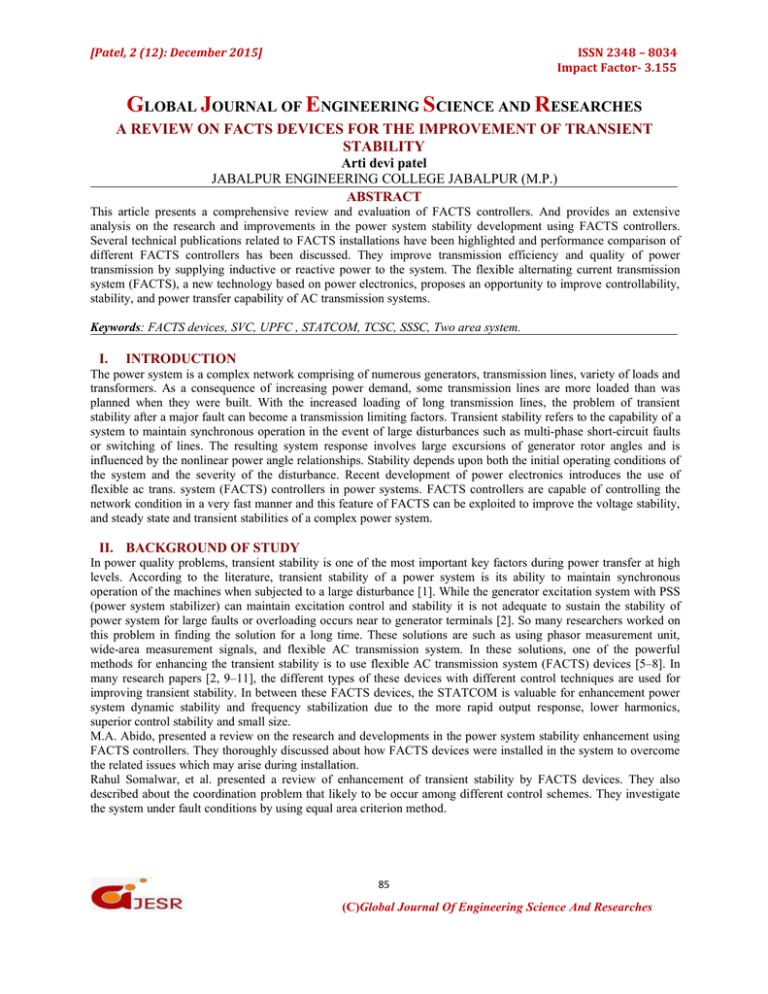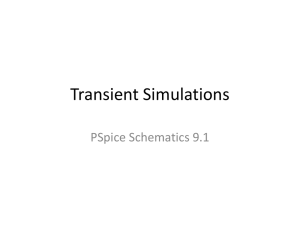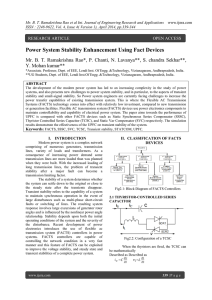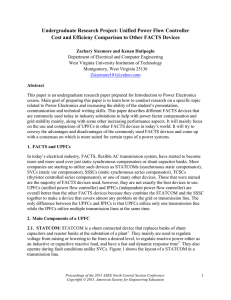C - Global Journal of Engineering Science and Researches-Home
advertisement

[Patel, 2 (12): December 2015] ISSN 2348 – 8034 Impact Factor- 3.155 GLOBAL JOURNAL OF ENGINEERING SCIENCE AND RESEARCHES A REVIEW ON FACTS DEVICES FOR THE IMPROVEMENT OF TRANSIENT STABILITY Arti devi patel JABALPUR ENGINEERING COLLEGE JABALPUR (M.P.) ABSTRACT This article presents a comprehensive review and evaluation of FACTS controllers. And provides an extensive analysis on the research and improvements in the power system stability development using FACTS controllers. Several technical publications related to FACTS installations have been highlighted and performance comparison of different FACTS controllers has been discussed. They improve transmission efficiency and quality of power transmission by supplying inductive or reactive power to the system. The flexible alternating current transmission system (FACTS), a new technology based on power electronics, proposes an opportunity to improve controllability, stability, and power transfer capability of AC transmission systems. Keywords: FACTS devices, SVC, UPFC , STATCOM, TCSC, SSSC, Two area system. I. INTRODUCTION The power system is a complex network comprising of numerous generators, transmission lines, variety of loads and transformers. As a consequence of increasing power demand, some transmission lines are more loaded than was planned when they were built. With the increased loading of long transmission lines, the problem of transient stability after a major fault can become a transmission limiting factors. Transient stability refers to the capability of a system to maintain synchronous operation in the event of large disturbances such as multi-phase short-circuit faults or switching of lines. The resulting system response involves large excursions of generator rotor angles and is influenced by the nonlinear power angle relationships. Stability depends upon both the initial operating conditions of the system and the severity of the disturbance. Recent development of power electronics introduces the use of flexible ac trans. system (FACTS) controllers in power systems. FACTS controllers are capable of controlling the network condition in a very fast manner and this feature of FACTS can be exploited to improve the voltage stability, and steady state and transient stabilities of a complex power system. II. BACKGROUND OF STUDY In power quality problems, transient stability is one of the most important key factors during power transfer at high levels. According to the literature, transient stability of a power system is its ability to maintain synchronous operation of the machines when subjected to a large disturbance [1]. While the generator excitation system with PSS (power system stabilizer) can maintain excitation control and stability it is not adequate to sustain the stability of power system for large faults or overloading occurs near to generator terminals [2]. So many researchers worked on this problem in finding the solution for a long time. These solutions are such as using phasor measurement unit, wide-area measurement signals, and flexible AC transmission system. In these solutions, one of the powerful methods for enhancing the transient stability is to use flexible AC transmission system (FACTS) devices [5–8]. In many research papers [2, 9–11], the different types of these devices with different control techniques are used for improving transient stability. In between these FACTS devices, the STATCOM is valuable for enhancement power system dynamic stability and frequency stabilization due to the more rapid output response, lower harmonics, superior control stability and small size. M.A. Abido, presented a review on the research and developments in the power system stability enhancement using FACTS controllers. They thoroughly discussed about how FACTS devices were installed in the system to overcome the related issues which may arise during installation. Rahul Somalwar, et al. presented a review of enhancement of transient stability by FACTS devices. They also described about the coordination problem that likely to be occur among different control schemes. They investigate the system under fault conditions by using equal area criterion method. 85 (C)Global Journal Of Engineering Science And Researches [Patel, 2 (12): December 2015] ISSN 2348 – 8034 Impact Factor- 3.155 III. FACTS CONTROLLERS FACTS devices are capable of controlling the network condition in a very fast manner by reactive power management and this unique feature of FACTS devices can be exploited to improve the transient stability of a system. Transient stability control plays a significant role in ensuring the stable operation of power systems in the event of large disturbances and faults. FACTS controllers are used for the dynamic control of voltage, impedance and phase angle of high voltage AC transmission lines. The basic principles of the following FACTS controllers, which are used in the two-area power system under study, are discussed briefly. A. Static Var Compensator (Svc):Static VAR Compensator (SVC) is a first generation FACTS device that can control voltage at the required bus thereby improving the voltage profile of the system. The primary task of an SVC is to maintain the voltage at a particular bus by means of reactive power compensation . The SVC uses conventional thyristors to achieve fast control of shunt-connected capacitors and reactors. The configuration of the SVC is shown in Fig.1.Which basically consists of a fixed capacitor (C) and a thyristor controlled reactor (L). The firing angle control of the thyristor banks determines the equivalent shunt admittance presented to the power system. , SVC is composed of a controllable shunt reactor and shunt capacitor(s). Total susceptance of SVC can be controlled by controlling the firing angle of thyristors. However, the SVC acts like fixed capacitor or fixed inductor at the maximum and minimum limits. Fig.1SVC connected to a transmission line. Fig.2 STATCOM connected to a transmission line. B. Static Synchronous Compensator (STATCOM) In the transmission systems, STATCOM provides voltage support to buses by modulating bus voltages during dynamic disturbances in order to provide better transient characteristics, improve the transient stability margins and to damp out the system oscillations due to these disturbances. The STATCOM is based on the solid state synchronous voltage source which generates a balanced set of three sinusoidal voltages at the fundamental frequency with rapidly controllable amplitude and phase angle. The configuration of a STATCOM is shown in Fig.2. Basically it consists of a voltage source converter (VSC), a coupling transformer and a dc capacitor. Control of reactive current and hence the susceptance presented to power system is possible by variation of the magnitude of output voltage with respect to bus voltage and thus operating the STATCOM in inductive region or capacitive region. C. Thyristor Controlled Series Capacitor (TCSC) TCSC is one of the most important and best known FACTS devices, which has been in use for many years to increase the power transfer as well as to enhance system stability. The main circuit of a TCSC is shown in Fig. 3. The TCSC consists of three main components: capacitor bank C, bypass inductor L & bidirectional thyristors SCR1 and SCR2. 86 (C)Global Journal Of Engineering Science And Researches [Patel, 2 (12): December 2015] ISSN 2348 – 8034 Impact Factor- 3.155 Fig.3 TCSC connected to a transmission line The firing angles of the thyristors are controlled to adjust the TCSC reactance in accordance with a system control algorithm, normally in response to some system parameter variations. According to the variation of the thyristors firing angle or conduction angle, this process can be modeled as a fast switch between corresponding reactance’s offered to the power system. D. Unified Power Flow Controller (UPFC) Among the available FACTS devices, the Unified Power Flow Controller (UPFC) is the most versatile one that can be used to enhance steady state stability, dynamic stability and transient stability. The basic configuration of a UPFC is shown in Fig. 4. The UPFC is capable of both supplying and absorbing real power and reactive power and it consists of two ac/dc converters. One of the two converters is connected in series with the transmission line through a series transformer and the other in parallel with the line through a shunt transformer. The dc side of the two converters is connected through a common capacitor, which provides dc voltage for the converter operation. The power balance between the series and shunt converters is a prerequisite to maintain a constant voltage across the dc capacitor. As the series branch of the UPFC injects a voltage of variable magnitude and phase angle, it can exchange real power with the transmission line and thus improves the power flow capability of the line as well as its transient stability limit. Fig 4 UPFC connected to a transmission line fig.5 SSSC connected to transmission line E. Static Synchronous Series Compensator (SSSC):SSSC is connected in series with a power system. It has a voltage source converter serially connected to a transmission line through a transformer. It can be considered as asynchronous voltage source as it can inject an almost sinusoidal voltage of variable and controllable amplitude and phase angle, in series with a transmission line. The injected voltage is almost in quadrature with the line current. A small part of the injected voltage that is in phase with the line current provides the losses in inverter. Most of the injected voltage, which is in quadrature with the line current, provides the effect of inserting an inductive or capacitive reactance in series with the transmission line. The variable reactance influences the electric power flow in the transmission line. The basic configuration of a SSSC is shown in Fig. 5. 87 (C)Global Journal Of Engineering Science And Researches [Patel, 2 (12): December 2015] ISSN 2348 – 8034 Impact Factor- 3.155 IV. COMPARISON BETWEEN UPFC, STATCOM, SVC, TCSC, AND SSSC FOR POWER SYSTEM STABILITY ENHANCEMENT Two Area Power System Model Consider a two area power system (Area-1 & Area-2) with series and shunt FACTS devices, connected by a single circuit long transmission line as shown in fig. 1 and fig. 2 respectively. Fig. 6 Twoarea power system with series FACTS device Here, the series FACTS devices such as UPFC (combination of STATCOM and SSSC), SSSC, and TCSC are equipped between bus-2 and bus-3. The direction of real power flow is from Area-1 to Area-2. Fig. 7 Two-area power system with shunt FACTS devices Here, the shunt FACTS devices such as STATCOM, SVC are equipped at bus-2. The direction of real power flow is from Area-1 to Area-2 . Two area power systems can be used for the problem identification in different FACTS devices. Also compare Shunt & Series, FACTS device for the improvement of power system stability. Fig.6 Two-area power system with series FACTS device devices Fig.7 Two-area power system with shunt FACTS Table 1 shows the comparison of FACTS devices of two-area power system with series and shunt FACTS devices. From table 1 it is investigated that the TCSC FACTS device UPFC is the effective device for load flow, voltage control and stability enhancement of inter-area power system. Table 1: Comparison between FACTS Devices for Power System Stability Enhancement FACTS Power System Stability Enhancement Load Flow Voltage Stability Transient Stability Dynamic Stability 1 UPFC Yes High High Medium Medium 2 TCSC Yes Medium Low High Medium 3 STATCOM Yes Medium High High Medium 4 SVC Yes Low High Low Medium 5 SSSC Yes Low High Low Medium V. CONCLUSION FACTS are powerful devices to improve the voltage profile and power system enhancement. In this paper, comparison of different FACTS devices with respect System Stability Enhancement is carried out and gives an idea about the FACT devices. It is found that the performance of the UPFC is higher for power system stability improvement is compared with the other FACTS devices such as SVC, TCSC, and SSSC respectively. Performance of TCSC is best for transient stability improvement but voltage profile is poor. In shunt FACTS devices performance of STATCOM is better because it improves transient stability as well as voltage profile of the power system. 88 (C)Global Journal Of Engineering Science And Researches [Patel, 2 (12): December 2015] ISSN 2348 – 8034 Impact Factor- 3.155 REFERENCES [1] D. Murali, Dr. M. Rajaram, N. Reka, “Comparison of FACTS Devices for Power System Stability Enhancement “International Journal of Computer Applications (0975 – 8887) Volume 8– No.4, October 2010. [2]. M. A. Abido, “Power system stability enhancement using facts controllers: a review,” The Arabian Journal for Science and Engineering, vol. 34, no. 2, pp. 153–172, 2009. [3] R. Mihalic, P. Zunko and D. Povh, 1996, “Improvement of Transient Stability using Unified Power Flow Controller,” IEEE Transactions on Power Delivery, 11(1), pp. 485-491. [4] N. G. Hingorani, and L. Gyugyi, Understanding FACTS, Concept and Technology of Flexible AC Transmission Systems, New York, Wiley Publishers, [5].R. J. Nelson, J. Bian, D. G. Ramey, T. A. Lemak, T. R. Rietman, and J. E. Hill, “Transient stability enhancement with FACTS controllers,” in Proceedings of the 6th International Conference on AC and DC Power Transmission, pp. 269–274, May 1996. [6]S. H. Hosseini and A. Ajami, “Transient stability enhancement of AC transmission system using STATCOM,” in Proceedings of the IEEE Region 10 Conference on Computers, Communications, Control and Power Engineering (TENCON '02), vol. 3, pp. 1809–1812, October 2002. [7]. M. H. Haque, “Improvement of first swing stability limit by utilizing full benefit of shunt facts devices,” IEEE Transactions on Power Systems, vol. 19, no. 4, pp. 1894–1902, 2004. [8]. A. Chakraborty, S. K. Musunuri, A. K. Srivastava, and A. K. Kondabathini, “Integrating STATCOM and battery energy storage system for power system transient stability: a review and application,” Advances in Power Electronics, vol. 2012, Article ID 676010, 12 pages, 2012. [9]. N. C. Sahoo, B. K. Panigrahi, P. K. Dash, and G. Panda, “Multivariable nonlinear control of STATCOM for synchronous generator stabilization,” International Journal of Electrical Power and Energy System, vol. 26, no. 1, pp. 37–48, 2004. [10]. H. Tsai, C. Chu, and S. Lee, “Passivity-based nonlinear STATCOM controller design for improving transient stability of power systems,” in Proceedings of the IEEE/PES Transmission and Distribution Conference & Exhibition: Asia and Pacific, pp. 1–5, IEEE, Dalian, China, 2005 89 (C)Global Journal Of Engineering Science And Researches





